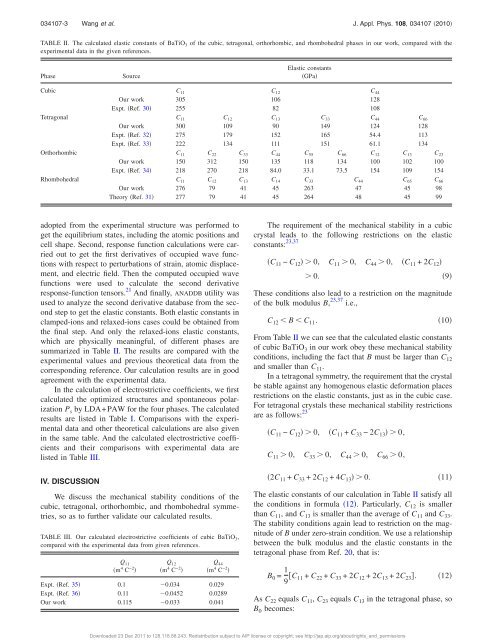Lattice, elastic, polarization, and electrostrictive ... - TheEEStory
Lattice, elastic, polarization, and electrostrictive ... - TheEEStory
Lattice, elastic, polarization, and electrostrictive ... - TheEEStory
Create successful ePaper yourself
Turn your PDF publications into a flip-book with our unique Google optimized e-Paper software.
034107-3 Wang et al. J. Appl. Phys. 108, 034107 2010<br />
TABLE II. The calculated <strong>elastic</strong> constants of BaTiO 3 of the cubic, tetragonal, orthorhombic, <strong>and</strong> rhombohedral phases in our work, compared with the<br />
experimental data in the given references.<br />
Phase<br />
Source<br />
Elastic constants<br />
GPa<br />
Cubic C 11 C 12 C 44<br />
Our work 305 106 128<br />
Expt. Ref. 30 255 82 108<br />
Tetragonal C 11 C 12 C 13 C 33 C 44 C 66<br />
Our work 300 109 90 149 124 128<br />
Expt. Ref. 32 275 179 152 165 54.4 113<br />
Expt. Ref. 33 222 134 111 151 61.1 134<br />
Orthorhombic C 11 C 22 C 33 C 44 C 55 C 66 C 12 C 13 C 23<br />
Our work 150 312 150 135 118 134 100 102 100<br />
Expt. Ref. 34 218 270 218 84.0 33.1 73.5 154 109 154<br />
Rhombohedral C 11 C 12 C 13 C 14 C 33 C 44 C 65 C 66<br />
Our work 276 79 41 45 263 47 45 98<br />
Theory Ref. 31 277 79 41 45 264 48 45 99<br />
adopted from the experimental structure was performed to<br />
get the equilibrium states, including the atomic positions <strong>and</strong><br />
cell shape. Second, response function calculations were carried<br />
out to get the first derivatives of occupied wave functions<br />
with respect to perturbations of strain, atomic displacement,<br />
<strong>and</strong> electric field. Then the computed occupied wave<br />
functions were used to calculate the second derivative<br />
response-function tensors. 21 And finally, ANADDB utility was<br />
used to analyze the second derivative database from the second<br />
step to get the <strong>elastic</strong> constants. Both <strong>elastic</strong> constants in<br />
clamped-ions <strong>and</strong> relaxed-ions cases could be obtained from<br />
the final step. And only the relaxed-ions <strong>elastic</strong> constants,<br />
which are physically meaningful, of different phases are<br />
summarized in Table II. The results are compared with the<br />
experimental values <strong>and</strong> previous theoretical data from the<br />
corresponding reference. Our calculation results are in good<br />
agreement with the experimental data.<br />
In the calculation of <strong>electrostrictive</strong> coefficients, we first<br />
calculated the optimized structures <strong>and</strong> spontaneous <strong>polarization</strong><br />
P s by LDA+PAW for the four phases. The calculated<br />
results are listed in Table I. Comparisons with the experimental<br />
data <strong>and</strong> other theoretical calculations are also given<br />
in the same table. And the calculated <strong>electrostrictive</strong> coefficients<br />
<strong>and</strong> their comparisons with experimental data are<br />
listed in Table III.<br />
IV. DISCUSSION<br />
We discuss the mechanical stability conditions of the<br />
cubic, tetragonal, orthorhombic, <strong>and</strong> rhombohedral symmetries,<br />
so as to further validate our calculated results.<br />
TABLE III. Our calculated <strong>electrostrictive</strong> coefficients of cubic BaTiO 3 ,<br />
compared with the experimental data from given references.<br />
Q 11<br />
m 4 C −2 <br />
Q 12<br />
m 4 C −2 <br />
Q 44<br />
m 4 C −2 <br />
Expt. Ref. 35 0.1 0.034 0.029<br />
Expt. Ref. 36 0.11 0.0452 0.0289<br />
Our work 0.115 0.033 0.041<br />
The requirement of the mechanical stability in a cubic<br />
crystal leads to the following restrictions on the <strong>elastic</strong><br />
constants: 23,37<br />
C 11 − C 12 0, C 11 0, C 44 0, C 11 +2C 12 <br />
0.<br />
9<br />
These conditions also lead to a restriction on the magnitude<br />
of the bulk modulus B, 23,37 i.e.,<br />
C 12 B C 11 .<br />
10<br />
From Table II we can see that the calculated <strong>elastic</strong> constants<br />
of cubic BaTiO 3 in our work obey these mechanical stability<br />
conditions, including the fact that B must be larger than C 12<br />
<strong>and</strong> smaller than C 11 .<br />
In a tetragonal symmetry, the requirement that the crystal<br />
be stable against any homogenous <strong>elastic</strong> deformation places<br />
restrictions on the <strong>elastic</strong> constants, just as in the cubic case.<br />
For tetragonal crystals these mechanical stability restrictions<br />
are as follows: 23<br />
C 11 − C 12 0, C 11 + C 33 −2C 13 0,<br />
C 11 0, C 33 0, C 44 0, C 66 0,<br />
2C 11 + C 33 +2C 12 +4C 13 0.<br />
11<br />
The <strong>elastic</strong> constants of our calculation in Table II satisfy all<br />
the conditions in formula 12. Particularly, C 12 is smaller<br />
than C 11 , <strong>and</strong> C 13 is smaller than the average of C 11 <strong>and</strong> C 33 .<br />
The stability conditions again lead to restriction on the magnitude<br />
of B under zero-strain condition. We use a relationship<br />
between the bulk modulus <strong>and</strong> the <strong>elastic</strong> constants in the<br />
tetragonal phase from Ref. 20, that is:<br />
B 0 = 1 9 C 11 + C 22 + C 33 +2C 12 +2C 13 +2C 23 .<br />
12<br />
As C 22 equals C 11 , C 23 equals C 13 in the tetragonal phase, so<br />
B 0 becomes:<br />
Downloaded 23 Dec 2011 to 128.118.88.243. Redistribution subject to AIP license or copyright; see http://jap.aip.org/about/rights_<strong>and</strong>_permissions
















